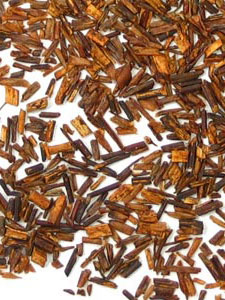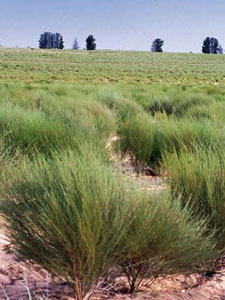A Brief Introduction to Rooibos


Deep in the heart of South Africa, in the mountains and valleys of the Cedarberg region near Cape Town, vast vistas, fields of verdant green bushes, fill the landscape. Traveling throughout this precipitous expanse, one may not suspect that this bright bush, which the locals refer to as "Rooibos," (pronounced roy-boss), could be such a versatile and remarkable herb. Among Rooibos' many uses, Rooibos' most popular utilization is as a tisane, or herbal beverage. Also known as Red tea, Bush tea (no relation to our 40th or 42nd President) and Redbush tea, Rooibos tea has become the hottest trend in the tea industry.
It's not easy bein' Red Like most tea (Camellia Sinensis tea... "real" tea), Rooibos tea goes through a fermentation process. Rooibos tea is finely chopped, bruised and left to ferment in heaps. Rooibos tea is then left to dry in the African sun, where it changes from a vivid green to a deep mahogany red the unique color which Rooibos tea is known and adored (and consumed).
The Dark Age of Rooibos Tea Rooibos tea remained virtually unheard of for centuries, known only to the Khoisans, a tribe of South African Bushmen. It was used frequently by these people as an herbal remedy for a wide range of ailments. The secret of this delicious herb nearly vanished into oblivion due to the environment and landscape, as the isolated tribe dwindled away and eventually disappeared.
Luckily, Rooibos tea was re-discovered in 1772 by botanist Carl Humberg, who then brought it back as a beverage. For generations after this, Rooibos tea was enjoyed (primarily by the South Africans) for it's cool, sweet, refreshing flavor. In 1904, a Russian immigrant named Benjamin Ginsberg realized Rooibos' untapped marketing potential, and began offering Rooibos tea globally calling Rooibos "Mountain Tea" as an herbal substitute to tea. Thus, the Worldwide Rooibos Revolution had begun.
A Place in the Sun Due to the difficulties buying and shipping tea (once again, I'm referring to "real" tea) from war-ridden Asia during World War II, the demand for a substitute beverage was urgent. Since Rooibos tea was such a fitting alternative, Rooibos' popularity rapidly rose.
But it wasn't until decades later that Rooibos teas' real success began. In 1968, South African mother Annique Theron (unfortunately, no relation to my favorite "Monster" Charlize Theron) fortuitously stumbled across Rooibos teas' ability to calm her baby, relieving the infant of colic and insomnia. Gratified by Rooibos' natural healing potential, Annique went on to investigate and document Rooibos' health-promoting properties. In 1970, Annique published her findings a book titled "Allergies: An Amazing Discovery." With this publication, Rooibos tea first became widely recognized worldwide.
The Rooibos Tea Revelations When Annique first made this discovery, it was impossible for her to know the many amazing health benefits Rooibos tea can provide. Throughout many years of rigorous scientific investigation, many benefits have surfaced and more are sure to follow. Foremost, Rooibos tea has been proven to contain many flavinoids, free-radical fighting antioxidants (similar to Polyphenols which have made Green tea famous). Even more alluring, unconfirmed studies are showing that these flavinoids may be up to 50 times more effective than those found in Green tea.
(for the health benefits of antioxidants, please visit the following link)
Also, studies are showing that Redbush's mellow flavor not only brings a delicious taste, but also other soothing effects. Being that Rooibos tea is naturally caffeine free (an especially important benefit for pregnant women, children and caffeine-sensitive drinkers), Rooibos tea can be consumed before sleep without caffeine's insomniatic stimulant side effects. Rooibos tea has also been shown to soothe the body's reaction to allergy and rashes (At an herbal store, you'll probably find Rooibos under the name "Herbal Allergy tea" due to this natural allergy-fighting quality). Rooibos tea also contains anti-spasmodic agents which can relieve stomach pains. In Asia, it is known as "Long Life" tea, in that many believe that Rooibos has anti-aging effects. Seemingly, Red tea is not only a wealth of health, but also a fountain of youth!
A "Novel" tea Recently, the tea industry has seen yet another resounding rush for Red Tea. Within the past year, sales for Rooibos tea have spiked about 70 percent. This is due partially to the fact that, of course, that tea is "hot," but also for more surreptitious means found in Pop Culture. Widely acclaimed throughout the media and a New York Times Bestseller, The No.1 Ladies Detective Agency by Alexander McCall Smith extols the delicious qualities of naturally sweet Rooibos tea. Set in Botswana, Africa, The No.1 Ladies Detective Agency is the first book in a series (of the same title), wherein the main character, Precious Ramotswe, frequently entertains clients and visitors with a cup of what is referred to as "Bush" tea or "Redbush" tea (these, as we know, are colloquialisms for Rooibos). The enormous success of this series seems to have catalyzed a remarkable demand for Red tea, bringing Rooibos tea once again to the forefront of the beverage world.
A "Red" by any other name... No matter what it is called (Red Tea, Redbush Tea, Bush tea, Mountain tea, Long life tea, Herbal Allergy tea or Rooibos Tea), all can agree that Rooibos is a delicious, naturally sweet and versatile beverage... but this isn't the full extent of Rooibos' utility. Currently, companies spanning many industries are developing innovative non-traditional methods to employ this handy herb. When added to lotions, Rooibos has been shown as an effective herbal remedy for skin ailments such as eczema and acne. In cooking, Rooibos tea has been shown to be an effective meat tenderizer and a wonderful marinade (for more cooking information, please visit the March 2004 issue)... Rooibos is also being used as a dye, a vitamin, a spice and just about anything that could be imagined (Not to mention the fact that Rooibos tea makes an interesting subject for a "Monthly Newsletter For Tea Aficionados!").
Rooibos tea has expanded from a small herb indigenous to a select region of South Africa, known only to a small group of tribesman, into one of the most consumed and well-known herbs in the world. The wonderful flavor and startling versatility make Rooibos worth the praise it has received, a mainstay for the converted and a must-try for the not-yet enlightened.
Learn where you can purchase an organic version of Rooibos Tea.
